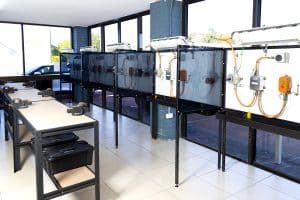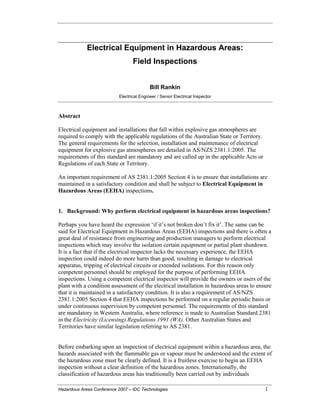How Roar Solutions can Save You Time, Stress, and Money.
How Roar Solutions can Save You Time, Stress, and Money.
Blog Article
Excitement About Roar Solutions
Table of ContentsGetting My Roar Solutions To WorkNot known Details About Roar Solutions Roar Solutions Fundamentals Explained
In order to protect installments from a prospective explosion an approach of analysing and classifying a potentially dangerous area is needed. The purpose of this is to make sure the correct option and installment of equipment to ultimately avoid a surge and to ensure safety and security of life.
(https://roar-solutions.mailchimpsites.com/)
No tools ought to be set up where the surface area temperature of the devices is more than the ignition temperature level of the given danger. Below are some typical dust dangerous and their minimum ignition temperature. Coal Dirt 380C 225C Polythene 420C (thaws) Methyl Cellulose 420C 320C Starch 460C 435C Flour 490C 340C Sugar 490C 460C Grain Dirt 510C 300C Phenolic Resin 530C > 450C Aluminium 590C > 450C PVC 700C > 450C Residue 810C 570C The possibility of the risk existing in a concentration high adequate to create an ignition will certainly differ from location to location.
Harmful location electric tools perhaps designed for use in higher ambient temperature levels. Area Fixing By Authorised Employee: Complex screening might not be required nevertheless particular treatments might need to be followed in order for the equipment to preserve its third celebration score. Each piece of equipment with a hazardous score must be reviewed independently.
Fascination About Roar Solutions
The tools register is an extensive data source of tools documents that consists of a minimum collection of areas to identify each thing's place, technical specifications, Ex classification, age, and ecological data. This info is crucial for monitoring and managing the equipment properly within harmful locations. On the other hand, for periodic or RBI sampling evaluations, the grade will be a mix of Detailed and Close examinations. The proportion of Thorough to Close assessments will be established by the Equipment Danger, which is evaluated based on ignition danger (the possibility of a resource of ignition versus the probability of a combustible environment )and the hazardous area classification
( Area 0, 1, or 2). This variant will also influence the resourcing needs for job prep work. Once Whole lots are specified, you can create sampling plans based on the example size of each Whole lot, which refers to the number of random tools products to be evaluated. To figure out the called for sample size, 2 elements require to be assessed: the size of the Lot and the classification of inspection, which shows the level of effort that should be applied( reduced, typical, or boosted )to the examination of the Whole lot. By integrating the category of examination with the Great deal size, you can after that develop the ideal being rejected standards for a sample, meaning the allowable variety of damaged things found within that example. For more information on this procedure, please describe the Power Institute Guidelines. The IEC 60079 standard recommends that the optimum interval between evaluations need to not exceed three years. EEHA examinations will certainly likewise be carried out outside of RBI projects as part of arranged maintenance and tools overhauls or repair services. These evaluations can be credited toward the RBI example dimensions within the impacted Lots. EEHA assessments are carried out to determine faults in electric devices. A weighted racking up system is important, as a single item of tools might have multiple faults, each with differing degrees of ignition threat. If the consolidated rating of both examinations is less than twice the fault score, the Great deal is deemed appropriate. If the Lot is still thought about undesirable, it has to undergo a full assessment or reason, which might cause stricter assessment procedures. Accepted Lot: The root causes of any kind of faults are recognized. If a typical failing setting is discovered, extra tools may require maintenance. Mistakes are classified by extent( Safety, Honesty, House cleaning ), ensuring that immediate issues are evaluated and addressed quickly to minimize any kind of influence on security or procedures. The EEHA database should track and tape-record the lifecycle of faults together with the rehabilitative activities taken. Executing a robust Risk-Based Evaluation( RBI )approach is essential for guaranteeing compliance and safety and security in handling Electrical Equipment in Hazardous Areas( EEHA) (high voltage courses). Automated Mistake Scoring and Lifecycle Administration: Easily take care of faults and track their lifecycle to boost examination precision. The intro of this support for risk-based assessment additionally strengthens Inspectivity's placement as a best-in-class option for regulatory conformity, in addition to for any asset-centric examination usage situation. If you want discovering more, we invite you to request a presentation and discover exactly how our solution can change your EEHA administration processes.
Little Known Facts About Roar Solutions.

In regards to eruptive threat, a dangerous location is an atmosphere in which an eruptive ambience exists (or may be expected to be present) in amounts that need unique precautions for the construction, installation and use tools. electrical refresher course. In this article we check out the obstacles dealt with in the workplace, the danger control steps, and the needed competencies to function safely
These materials can, in certain problems, create eruptive atmospheres and these can have significant and awful effects. Most of us are familiar with the fire triangle eliminate any type of one of the 3 elements and the fire can not occur, however what does this mean in the context of harmful locations?
In the majority of circumstances, we can do little regarding the degrees of oxygen in the air, yet we can have considerable impact on resources of ignition, as an example electric tools. Harmful areas are recorded on the hazardous area classification illustration and are identified on-site by the triangular "EX-SPOUSE" indication. Here, among other crucial info, areas are split right into 3 types depending upon the threat, the chance and duration that an eruptive environment will exist; Area 0 or 20 is deemed the most harmful and Zone 2 or 22 is deemed the least.
Report this page